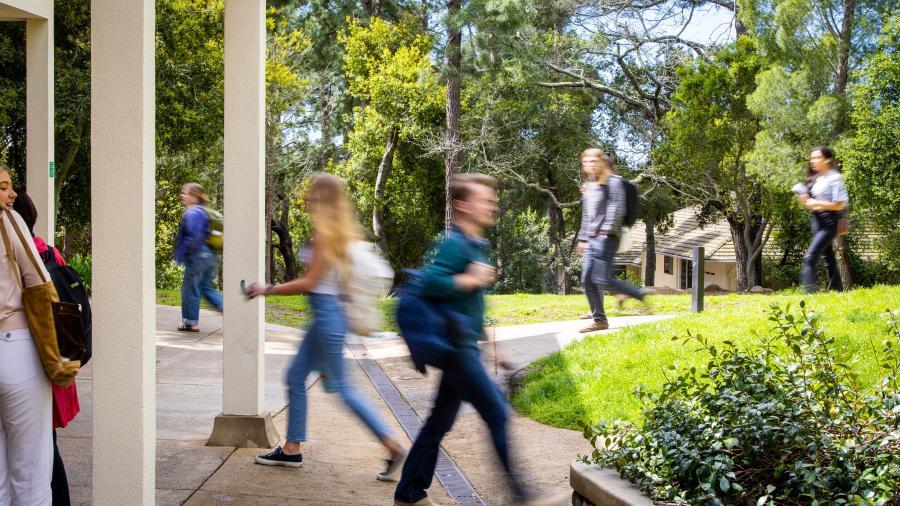Westmont Magazine Walking: What You’ll Actually Miss Most About College

by Evan Tsuei '23 (This story originally appeared on studybreaks.com on October 16, 2022.)
Where do you see yourself 10 years after graduation? If all goes well, you’ll find yourself well established in a fulfilling career, leaving your college days behind you. But everyone has heard people reminisce about the good old days, often in reference to being an undergraduate. To reframe the question, 10 years down the road, what do you think you’ll miss the most about college? Is it the varied schedule and reliable structure to your day, or the easy access to food of questionable nutritious value? Will it be the friends you made among your peers, or the mentor you found in a teacher? All these and more can fall under one banner: walkability. That’s right, you’re going to miss the walking.
With some exceptions, this is probably the only time in your life you’ll live in a safe, walkable community. Simply put, walkability refers to how friendly an area is to pedestrian traffic, including all factors that might promote walking and public transit instead of traveling by car. This means building spaces centered around the needs of humans rather than the needs of cars. At college, most aspects of a fulfilling life are conveniently accessible without disturbing a healthy work-life balance.
A clear difference exists between college life and life before and after college. There is no hour-long commute since everything you might need — classes, library, campus store, cafeteria, campus job, friends, public spaces — all lie within walking distance. For many students, college offers unprecedented freedom to go where they like whenever they like, a benefit that goes along with the newfound independence and responsibility of this stage of life.
This living situation and lifestyle certainly sound appealing, but what are the actual benefits of living in a walkable community beyond pure convenience? It’s not as lazy as it sounds. Walkability makes a direct impact on environmental and public health, such as limiting pollution from automobiles — improved air quality benefits both the environment and people’s lungs — and promoting transportation alternatives that facilitate regular exercise such as biking, running to catch a ride on public transit, or, of course, walking. College is a good time to get in shape not only because you’re close to the prime of your life, but because walkable campuses promote an active lifestyle.
Walkable communities tend to be more accessible and more diverse. Poorly maintained or even nonexistent sidewalks often exclude people with disabilities. Centering the design of an area around the concept of walkability reveals many barriers to walkability and accessibility that may have been overlooked, such as dangerous traffic patterns, unprotected or nonexistent bike lanes, and even poorly placed utility poles that might prevent a wheelchair from getting down a sidewalk.
Walkable communities feature communal spaces where people can come together and freely interact. Walkability increases connectivity and creates a more diverse community by offering a desirable lifestyle, opening a space to a wider range of people and creating a place for people to gather.
Sadly, this experience remains somewhat rare in America. Most places operate under a different set of building rules and policies than many college campuses, usually to the detriment of a walkable lifestyle. Rural areas have a lot of walkability potential, given the small scale of many towns, but the low population density combined with limited infrastructure like sidewalks or mass transit leaves walking a less-than-viable transportation option. Suburbs are about as anti-walkability as you can get. Besides their inefficient population density and the fact that they only exist due to government subsidies, suburbs enjoy little access to public transit, limited community space, and zero mixed-use property zoning. They deprive residents of any reason to exit their homes in anything but an automobile. Suburbs are literally designed to minimize foot traffic.
The next best alternative to college life is probably the city, but walkability is uncommon. Even when you find a walkable community, you’ll encounter the persistent problem of money. It’s expensive to enjoy something approximating the benefits of college living; it’s almost like paying tuition all over again. Look at the West Village neighborhood in Manhattan, New York, one of the most expensive places to live in the United States. Its easy access to mass transit, variety of restaurants and stores, and its quiet streets and beautiful architecture give people a reason to go outside and mingle. The West Village is a perfect walkable community open to everyone who can afford its astronomical price tag.
Why is it so difficult to spread the benefits of walkability around the country at affordable prices? Public policy. As with government-subsidized and terribly inefficient suburbs, cities often pass legislation directly opposed to building walkable communities. San Francisco, considered to be one of the most walkable cities in the country, is infamous for its high home prices and large homeless population, problems only worsened by its refusal to approve the construction of high-density housing. Laws about jaywalking and loitering are repeatedly used to discriminate, favor cars at the expense of people, and serve only to inhibit the cultivation of a healthy community that can take full advantage of a walkable city.
Our car-centric culture and challenge to effectively address the housing crisis create complicated conversations. An important first step is determining what you want the end goal to be. Be aware of your habits, consider how your space is designed to promote or inhibit a healthy and fulfilling lifestyle, and think about changing the way you vote on measures that promote a more walkable community. You can’t return to the good old days, and there’s still plenty to miss about college. But you should be able enjoy the benefits of college living beyond those four short years.
